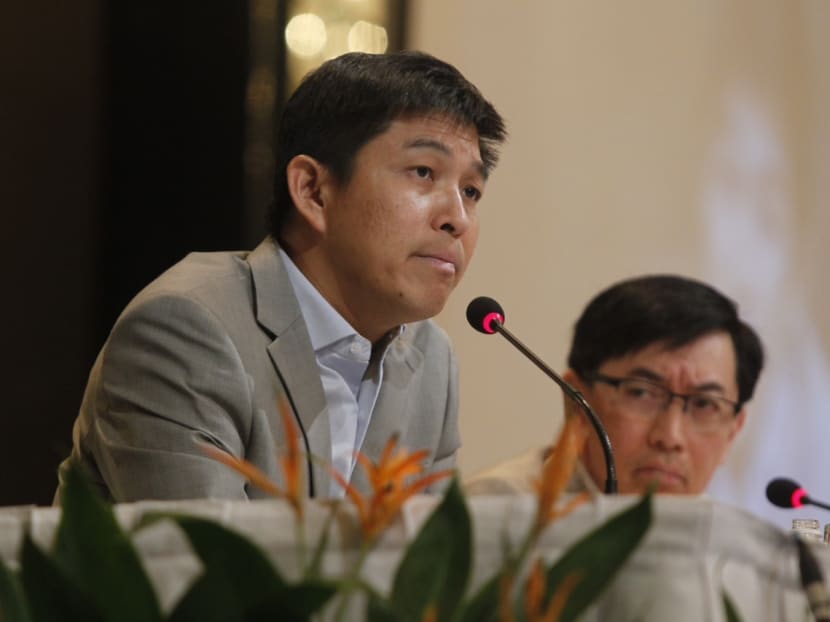Minimum Sum among aspects under review
SINGAPORE — Amid intense public debate over the Central Provident Fund (CPF) scheme, the Government is reviewing various aspects of the scheme, including how the CPF Minimum Sum is calculated, and possible options to help the asset-rich but cash-poor.

Minister for Manpower Tan Chuan-Jin (left) at the Insitutue of Policy Studies' forum on CPF and Retirement Adequacy. Photo: Don Wong
SINGAPORE — Amid intense public debate over the Central Provident Fund (CPF) scheme, the Government is reviewing various aspects of the scheme, including how the CPF Minimum Sum is calculated, and possible options to help the asset-rich but cash-poor.
It could also study options for CPF members to try and earn higher returns, such as by allowing members to invest CPF monies in private pension plans, and review the current income cap on employer contributions to CPF.
This was shared at an Institute of Policy Studies forum on CPF and retirement adequacy yesterday, where Deputy Prime Minister Tharman Shanmugaratnam and Manpower Minister Tan Chuan-Jin took part in dialogue sessions with academics and members of the public.
Mr Tan, who spoke at a session in the morning, said concerns about inflation impacting on retirement adequacy are valid. “One of the measures we have put in place really is in terms of interest rates ... But (inflation) is a valid concern (and) that is one area we have been looking at,” he said. “It is something we will be making some announcements on.”
In the meantime, the Government is reviewing how the CPF Minimum Sum is being calculated, which will in turn affect how much the Minimum Sum should be raised against inflation. The CPF Minimum Sum is currently pegged to inflation using the Consumer Price Index (CPI) and adjustments are made every year.
Responding to a question on whether it is fair to include the imputed rent component in the CPI, Mr Tan said that “we may want to consider not including” imputed rent when computing Singapore’s inflation rates.
The CPF scheme has come in for intense debate over the past few weeks, with concerns from the public over the raising of the Minimum Sum, the level of returns on CPF savings, and whether it can adequately meet retirement needs.
In Parliament earlier this month, Mr Tan made a 20-minute speech to dispel “misconceptions and myths” over the Minimum Sum, while Mr Tharman detailed how the CPF Board invests the savings of workers.
Mr Tharman, who spoke during the closing dialogue session yesterday, made clear that the CPF is aimed at tackling basic needs, hence the wage ceiling on employer CPF contributions. Currently, CPF contribution from employers is payable on ordinary wages of up to S$5,000 per month.
“(CPF) is aimed at basic retirement needs. It is not aimed at catering to the full retirement needs of the upper-middle-income group or the higher-income group,” he said, in response to a question from Mr Patrick Daniel, editor-in-chief at Singapore Press Holdings’ English and Malay Newspapers Division, who had asked whether the Government has a certain segment of the population in mind when reviewing the CPF scheme. This, of course, would be reviewed over time, he said. “We pegged it at the 80th percentile of incomes and over time we will see how we should adjust the salary cap,” he said.
Responding to suggestions from speakers on providing better options — than currently provided for under the CPF Investment Scheme system — for CPF members who are able to take on higher risks so that they can try to earn higher returns, Mr Tharman said this is an area the Government can study. An option that remains on the table is allowing members to use CPF monies to invest in private pension plans. However, the Government has to study any new options carefully, take in views and ensure that everyone understands the risks involved, said Mr Tharman, who is also Finance Minister.
“It doesn’t mean these are ill-conceived funds. In principle, in the long term, you should expect to earn higher returns for higher risks. But you can go through long periods where higher returns do not materialise. That is the basic lesson from the evidence on market cycles,” he said, adding that the CPF is already offering good returns for risk-free assets.
He acknowledged that many Singaporeans in the older generation are asset-rich but cash poor. “We will help them get cash out of their homes. Some of today’s speakers have suggested ways of doing this, and there are ways, which we are studying very seriously.”
Asked by an audience member on plans for the next 50 years, Mr Tharman was optimistic. He said: “We are in the rare position of being able to strengthen our system as we go forward, while most other systems are having to cut back on benefits or raise more taxes to sustain their social security systems. We are in a very rare situation of starting from a very strong foundation and being able to improve our system, and improve we will.”






